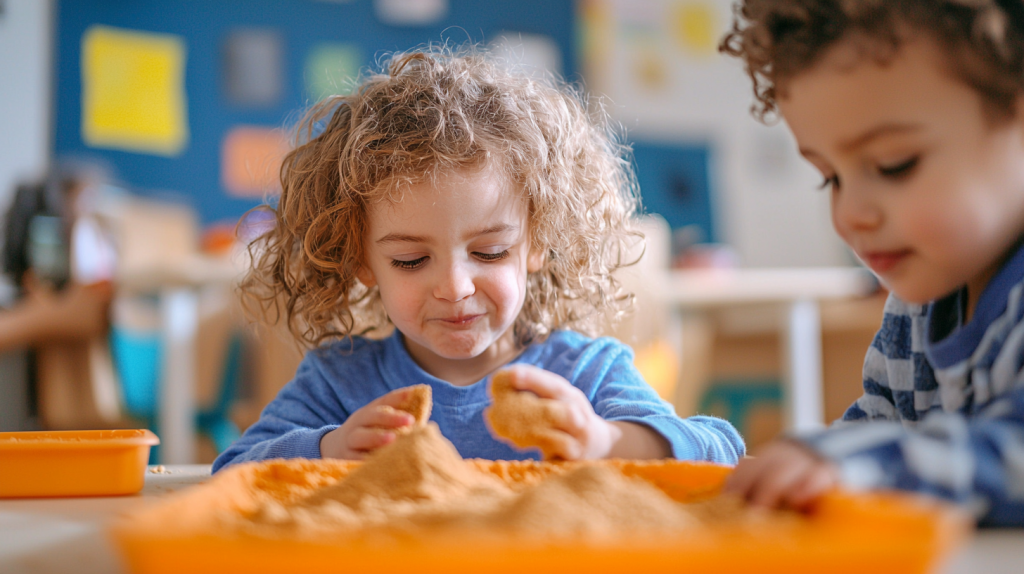
Have you ever wondered how sand can stay dry in water? That’s right, this seemingly impossible phenomenon is now a reality! Welcome to the magical world of magic sand, which is not just an amusing toy but also a perfect tool for kids to explore science.
Imagine children watching sand float on water without a single grain getting wet—doesn’t that make you want to learn more? In this article, we’ll explore how magic sand plays a role in children’s education, and how simple experiments can teach kids scientific principles while they have fun!
Magic sand is a seemingly ordinary type of sand, but its unique hydrophobic properties have made it a new favorite in children’s education. Not only does it capture kids’ attention, but it also sparks their interest in science, physics, and chemistry.
Magic sand is ordinary sand that has been treated with a hydrophobic substance like trimethylsilane. This coating prevents water from interacting with the sand, causing the sand to remain dry in water and float on the surface like little buoyant particles that clump together.
This property makes magic sand behave very differently from ordinary sand in water, offering kids a unique visual experience. It’s not just a toy; it’s a perfect tool to showcase scientific phenomena to children.
The main feature of magic sand is its water-repellent nature, which arises from surface tension and the molecular structure of water. When water meets magic sand, the hydrogen bonds between water molecules can’t form with the sand’s surface. This phenomenon is a direct manifestation of surface tension, and kids can observe how water forms little droplets on the magic sand.
By observing this, kids can start to understand the concept of liquid surface tension. Teachers or parents can perform simple experiments to help kids grasp the unique properties of water, thereby sparking their interest in physics.
Magic sand is not just for demonstrating scientific principles—it’s also a fantastic hands-on toy. Kids can use magic sand to build various shapes, castles, or roads. Unlike regular sand, the special properties of magic sand make it more stable when constructing structures, and it allows for more creative experiments in water.
For example, kids can try building waterproof structures with magic sand and observe how they hold their shape underwater. This helps them understand basic principles of architecture and engineering. These creative activities not only develop kids’ hands-on skills but also hone their problem-solving and teamwork abilities.
The magical properties of magic sand can spark strong curiosity in children. Why does magic sand stay dry in water? What scientific principles are behind this phenomenon? These questions give kids opportunities to think and explore, further igniting their interest in scientific experiments.
Parents and teachers can guide kids through different magic sand experiments, encouraging them to ask questions and try to find the answers. This spirit of exploration will lay the foundation for their future learning and help them develop critical thinking skills.

Pour magic sand into a transparent container and then add water. Watch how the magic sand forms clumps on the surface without getting wet. You can let kids gently touch the sand particles to see if they get wet. This simple experiment will pique kids’ interest in magic sand.
Put some magic sand into the water and observe how it floats. Then, take the sand out and see how it behaves in the air. This experiment helps kids understand how objects behave differently in various mediums.
Provide kids with magic sand, transparent containers, building tools, and water, and encourage them to build sandcastles or other structures. Let them test the stability of different designs and discuss how magic sand helps maintain the structural integrity.
Magic sand’s unique properties require kids to think about how to use it to solve problems. For example, how can you keep the sand dry in water? How can you use magic sand to build a sturdier structure? These questions help kids improve their problem-solving abilities and foster creative thinking.
In group activities, kids can work together using magic sand for experiments or construction. Cooperation and communication are key to successfully completing tasks, and magic sand provides a platform for teamwork, where kids can learn how to divide responsibilities, share ideas, and solve problems together.
Magic sand is not only an entertaining science toy but also an excellent educational tool for children. Through simple experiments and creative activities, kids can learn fundamental principles of physics, chemistry, and engineering. At the same time, it fosters their creativity, hands-on skills, and teamwork. Whether you’re a parent or a teacher, magic sand offers a fun and educational science exploration journey for kids.
For any questions or quotes about our Sensory Sands!